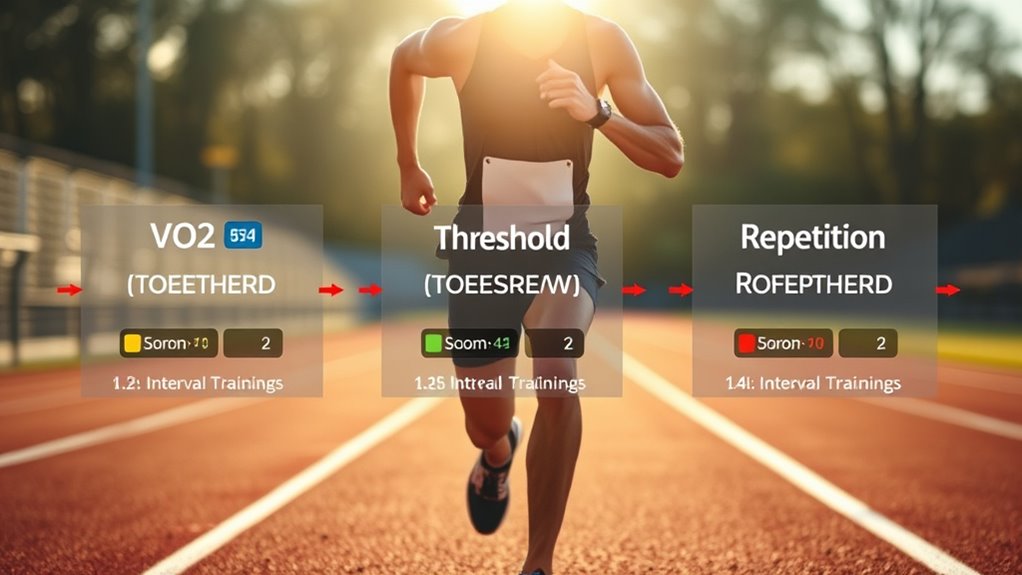Interval training offers three main types: VO2 max efforts push your cardiovascular limits with high-intensity intervals lasting 3 to 8 minutes; threshold intervals help improve endurance by maintaining efforts at 80-90% of your max heart rate for 10 to 20 minutes; repetition intervals develop speed and muscular endurance with shorter efforts from 30 seconds to 2 minutes. Each type uses specific timing and recovery strategies. Keep exploring to understand how to optimize each for your fitness goals.
Key Takeaways
- VO2 max intervals push cardiovascular capacity with efforts at 90-100% VO2 max for 3-8 minutes.
- Threshold intervals target anaerobic threshold, lasting 10-20 minutes at 80-90% max heart rate.
- Repetition intervals develop speed and muscular endurance with efforts from 30 seconds to 2 minutes.
- Proper interval timing and recovery strategies optimize training intensity and prevent fatigue.
- Tailoring interval types and recovery methods enhances cardiovascular and muscular adaptations.

Are you curious about the different types of interval training and how they can boost your fitness? Understanding the main types—VO2, threshold, and repetition intervals—can help you tailor your workouts to meet specific goals. Each type relies on precise interval timing, which determines how long you work and recover, making recovery strategies essential to optimizing performance and avoiding burnout.
VO2 max intervals push your aerobic capacity to its limit. During these sessions, you perform high-intensity efforts at around 90-100% of your maximum oxygen uptake, typically lasting 3 to 8 minutes. The goal here is to challenge your cardiovascular system, increasing your VO2 max over time. To get the most out of VO2 intervals, you need effective recovery strategies. After each hard effort, you allow yourself enough rest—often equal to or slightly less than the work period—to maintain high intensity without excessive fatigue. Proper interval timing ensures you stay within the targeted intensity zone, maximizing oxygen utilization and cardiovascular adaptation.
VO2 max intervals boost aerobic capacity with high-intensity efforts and precise recovery strategies.
Threshold intervals focus on improving your anaerobic threshold, the point where your body shifts from mainly aerobic to more anaerobic metabolism. These workouts usually involve sustained efforts at around 80-90% of your maximum heart rate, often lasting 10 to 20 minutes per interval. The key is maintaining a challenging but sustainable pace, which requires precise interval timing. Recovery strategies between sets are typically active, like light jogging or walking, allowing your heart rate and breathing to stay elevated but manageable. This approach helps you build endurance and delay fatigue, making your body more efficient at clearing lactate and sustaining higher intensities for longer periods.
Repetition intervals are shorter, sharper efforts designed to develop speed and muscular endurance. They often last from 30 seconds to 2 minutes, with equal or slightly longer recovery periods. During these sessions, interval timing is critical; resting too long diminishes the training effect, while resting too little can lead to incomplete recovery and reduced intensity. Effective recovery strategies here involve active rest, such as slow jogging or walking, which keeps your muscles engaged while allowing partial recovery. These intervals are excellent for athletes looking to improve their power and quickness, especially when combined with targeted recovery strategies that prevent overtraining.
In all these types, understanding how to manage interval timing and recovery strategies is essential. Properly timed work and rest periods ensure you stay within the desired intensity zone, prevent burnout, and promote steady progress. By customizing your intervals based on your fitness level and goals, you can make your workouts more effective, challenging, and rewarding.
Frequently Asked Questions
How Do I Determine My Ideal Interval Training Duration?
To determine your ideal interval training duration, consider your fitness level and workout intensity. Generally, shorter intervals of 30 seconds to 2 minutes work well for high-intensity sessions, while longer ones of 3 to 5 minutes suit moderate intensity. Pay attention to how your body responds; if you’re overly fatigued, reduce the duration. Adjust based on your goals and gradually increase as endurance improves.
Can Beginners Safely Perform All Types of Interval Training?
You might worry that all interval training is too intense for beginners, but with proper progression, it’s safe. Start with low-intensity sessions and gradually increase duration and intensity to guarantee beginners’ safety. Focus on listening to your body, and don’t push too hard too soon. Incorporating gentle recovery periods helps prevent injury, making all types of interval training accessible and beneficial even for newcomers.
How Often Should I Incorporate Interval Training Into My Routine?
You should incorporate interval training into your routine 2 to 3 times a week for ideal results. Keep your interval frequency moderate to prevent overtraining and guarantee consistent progress. Focus on training consistency by gradually increasing intensity or duration as your fitness improves. Remember, listening to your body is key; if you feel overly fatigued, allow more recovery time before your next session.
What Are Common Mistakes to Avoid During Interval Sessions?
Think of your interval session as a tightrope walk—you need balance to succeed. Avoid common mistakes like pushing too hard too soon, which can lead to burnout or injury. Always prioritize proper pacing, so you don’t overexert yourself. Also, guarantee your equipment is safe and well-maintained to prevent accidents. Staying mindful of these details helps you stay on course, making your training effective and injury-free.
How Does Interval Training Impact Long-Term Athletic Performance?
Interval training boosts your long-term athletic performance by increasing stamina, speed, and recovery efficiency. It enhances your body’s ability to handle intense efforts, leading to better race times and endurance. To maximize benefits, use effective recovery strategies, like proper rest and nutrition, which reduce injury risk and improve adaptation. Consistent, well-structured sessions help you progress safely, ensuring sustained improvements and long-term athletic growth.
Conclusion
By exploring different interval training types like VO2, threshold, and repetition, you gently discover new levels of fitness. Each method offers a subtle way to challenge yourself, helping you grow stronger without pushing too hard. Embrace the variety as a natural rhythm in your journey, allowing progress to flow smoothly. With patience and consistency, you’ll find your limits expanding, and your goals becoming just a little more within reach—step by step, breath by breath.









